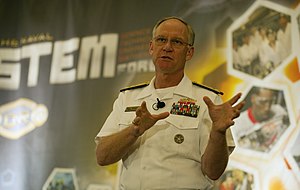
Rear Adm. Nevin Carr, Chief of Naval Research, delivers opening remarks at the Office of Naval Research-hosted Naval Science, Technology, Engineering and Mathematics (STEM) Forum. (U.S. Navy photo by John F. Williams/Released) (Photo credit: Wikipedia)
Is there really a “STEM crisis”? To the discouragement of art history students everywhere, we frequently hear politicians, business leaders, and others warn of dark social and national consequences unless we significantly ramp up the percentage of students majoring in science, technology, engineering, and mathematics, the four pillars of the STEM acronym. This has always rung a bit hollow to many of us who actually spend time dealing with scientists, who hear tales of hapless souls bouncing from postdoc to postdoc with no steady job prospect in sight, who observe the popularity of the “alternative careers” sections of the Nature and Science careers sites, and who read ruminations like this one, in which the author sees the current landscape for biology “knowledge workers” as something approaching indentured servitude:
I have seen a comparison of a postdoc with a piece of equipment that is replaced whenever there is a new model on the market—and nobody buys a second-hand Polymerase Chain Reaction machine. Despite what I feel are excellent skills, I feel like a used piece of equipment.
If there is indeed a crisis in the pipeline of STEM workers to drive future innovation, how do we explain outpourings like this — which, believe me, are not rare?
One obvious possible answer is that, political cant to the contrary, there is no “STEM crisis” at all. The most exhilarating recent smackdown of the hypothesized STEM worker shortage appeared in an August 2013 IEEE Spectrum article by Robert Charette, candidly titled “The STEM Crisis Is a Myth.” Bringing to bear equal parts data and withering sarcasm, Charette shows that, notwithstanding the billions of dollars that governments are pouring into boosting STEM education efforts, there are already far fewer STEM jobs than there are qualified candidates to fill them; that false warnings of a STEM crisis have been a recurring theme from political and business leaders since the end World War II, not just in the U.S. but in other countries; and that STEM wages are not showing anything like the growth one would expect given a labor shortage. As is de rigueur on the Web, the article boils the matter down to a single, devastating infographic that compares the huge pool of STEM degree holders already working outside of their chosen field with the comparatively puny number of new jobs.
Given these data, why all the talk of a “STEM crisis”? In a peroration that stirred the few remaining embers of my youthful socialism, Charette finds the answer in a powerful combination of capitalist vested interests, seeking to ensure an oversupply of knowledge workers to keep wages down and the bottom line up:
No less an authority than Alan Greenspan, former chairman of the Federal Reserve, said as much when in 2007 he advocated boosting the number of skilled immigrants entering the United States so as to “suppress” the wages of their U.S. counterparts, which he considered too high.
(This particular quote prompted the amusing rejoinder from a former colleague of mine that “Maybe we need more H1-B visas to bring down economists’ pay.”)
Charette’s article did leave me wondering, though, whether part of the problem lies in the acronym “STEM” itself. Does the supply of jobs in enterprises as different as basic science, technology, engineering, and mathematics really respond monotonically to the same economic forces? The obvious answer is no, and is implicit even in some of the evidence that Charette adduces to eviscerate the supposed STEM crisis, sensu lato. John Miano, writing at the end of 2011, notes that in the previous year the U.S. “lost 19,740 computer jobs, 107,200 engineering jobs, and 243,870 science jobs, according to the Bureau of Labor Statistics” — losses across the board, admittedly, but of very different magnitude, with the broad category of “science jobs” clearly suffering the most. Do we have a “STEM crisis,” or only a “TEM crisis”?
A report from the American Institutes for Research weighs in firmly on the side of the latter. Titled “Higher Education Pays: But a Lot More for Some Graduates Than for Others,” this study — which should be read by, among others, any college-bound senior or parent thereof — looked at data from five states on the earnings of college graduates when they entered the labor force. The report concluded that, by this one metric at least, what students study is a lot more important than where they study, targeted short-term Associate’s degrees can have a lot more immediate earnings power than Bachelor’s degrees, and, most provocatively, “the ‘S’ in STEM . . . is oversold”: “Evidence does not suggest that graduates with degrees in Biology earn a wage premium—in fact, they often earn less than English majors.”
Less than English majors? Mon Dieu! [Full disclosure: the author of this post earned his first Bachelor’s in English, and has no regrets.]
Even within the separate divisions that make up the STEM rubric, things are far from homogeneous. An interesting and somewhat bewildering Congressional Research Service report from the past May on the science and engineering workforce projects that the largest number of new jobs through 2020 will come in areas like software development, civil engineering, and medical science, whereas some other engineering sectors such as agricultural engineering, mining engineering, and marine engineering, scientific sectors such as materials science and space science, and mathematics generally will see the smallest number of new jobs created. A recent episode of NPR’s “Planet Money” series suggested that for students going to school today, petroleum engineering is the true road to riches. Clearly, where the “STEM crisis” is concerned, we need to be splitters, not lumpers.
All of this matters because, as Charette correctly notes, our rush to throw funding, energy, and rhetoric at a STEM crisis that is, at best, highly variable and, at worst, an illusion not only condemns today’s students to disappointment, but also risks crowding out support for other worthwhile areas of human experience — “the arts, literature, and history” — that have traditionally carried intangible but real benefits in both the soul and the workplace. In perhaps the most revealing extract from the entire article, Charette quotes the former chairman of Lockheed-Martin, who wrote, in an op-ed for the Wall Street Journal:
In my position as CEO of a firm employing over 80 000 engineers, I can testify that most were excellent engineers . . . But the factor that most distinguished those who advanced in the organization was the ability to think broadly and read and write clearly.
Well! Perhaps that English degree was worth something after all. Somewhere, my late father, who paid the tuition, must be smiling.


